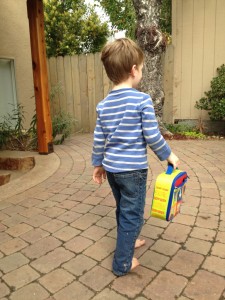Pilates Practice Pointer: Make the Most of the First Day

First Official Day of School (photo taken upon returning home)
Today’s the day I’ve been waiting for – my son’s first official day of school! It’s not actually what it seems, I haven’t been suffering through a seemingly interminable summer of boredom or hyperactivity. No. More importantly for me, his first day of school is the first day of my new schedule, the one that I’ve been gearing up for for weeks. Yes, I’m an organizational nerd. Yes, I’m just happy that my plans are finally happening. And yes, I love symbolism.
I’ve realized that this is just the beginning of first days and new routines in my life as a parent. And isn’t that similar to our fitness rhythms? Life is so full, it seems that not many routines last too long. And why should they? Our bodies are constantly changing, our care and maintenance of them would logically shift too. Anybody that knows me realizes that I’m not a typical fitness instructor in that my exercise has always been balanced with a fair amount of self-care work to manage my delicate back and I’m certainly not into high reps and feeling the burn, but I have come to understand that our bodies respond positively to variety. I’ve been setting up routines for myself for a while, and I love doing the same with clients because it enhances our focus in the studio.
Pilates has been a constant for me since 2000, so I’ve come up with a few ways to vary my Pilates practice and begin again. Here’s my summary.
It’s a good idea to establish a start and end date for any routine. Having a particular goal in mind and a way of measuring attainment of that goal is the best way that I’ve found to stick to my plan. Sharing before and after photos has worked well for me as a mom who has precious little time to go out in the world and get external feedback. That framework has kept me disciplined with my workouts. In the past, I had teachers and colleagues, now I’ve got a camera and the internet. Lucky for my clients though, they’ve got me to cheer them on.
1) Start with selecting an apparatus to work on for a set period of time (although, in some cases the area of the body or the specific goal will be the more logical point of departure.)
2) Next select an area of your body that you want to improve. overall flexibility or strength, connection of legs or arms to center, reducing neck tension, backbends, eliminating aches and pains, and fixing the feet are some good examples.
3) The apparatus and area of your body will help you determine a specific goal or two to focus on during your workouts, select one or two: minimum of motion, alignment, precision, back connecting to the mat, breathing coordination throughout the workout, frequency, rhythm and duration of sequence are some good examples.
4) Based on your selections, you will most likely have a pretty good idea of the exercises that you’ll be doing. But you may want to put together a special list based on your parameters.